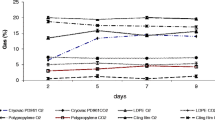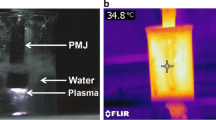Abstract
This study reports on aflatoxin production and peanut (Bailey’s variety) quality, for four peanut pre-storage treatments; [(Raw clean (Raw-Cl), Raw inoculated with Aspergillus flavus NRRL 3357 (Raw-Inf), inoculated partially roasted but not-blanched (PRN-blanch); and inoculated partially roasted, blanched with discolored nuts sorted out (PR-blanched)]. All four treated samples were packaged in four different packaging systems [polypropylene woven sacks (PS), hermetic packs (HP), hermetic packs with oxygen absorbers (HPO), and vacuumed hermetic packs (HPV)] and stored under controlled conditions at a temperature of 30 ± 1 °C and water activity of 0.85 ± 0.02, for 14 weeks. Raw-Inf samples in PS had a higher fungal growth with a mean value of 8.01 × 104 CFU/g, compared to the mean values of samples in hermetic packs: 1.07 × 103 CFU/g for HP, 14.55 CFU/g for HPO, and 57.82 CFU/g for HPV. Similarly, the hermetic bags were able to reduce aflatoxin level of the Raw-Inf samples by 50.6% (HP), 63.0% (HPV), and 66.8% (HPO). Partial roasting and blanching in PS also reduced aflatoxin level by about 74.6%. Quality maintenance was the best for peanuts in HPO, recording peroxide value (PV) of 10.16 meq/kg and p-Anisidine (p-Av) of 3.95 meq/kg compared to samples in polypropylene woven sacks which had PV of 19.25 meq/kg and p-Av of 6.48 meq/kg. These results indicate that using zero-oxygen hermetic packaging, instead of the conventional polypropylene woven sacks, helped to suppress aflatoxin production and quality deterioration. Also, partially roasted, blanched and sorted peanuts showed a potential for reducing aflatoxin presence during storage.



Similar content being viewed by others
References
Akbas MY, Ozdemir M (2006) Effect of different ozone treatments on aflatoxin degradation and physicochemical properties of pistachios. J Sci Food Agric 86(13):2099–2104
Barriuso B, Astiasarán I, Ansorena D (2013) A review of analytical methods measuring lipid oxidation status in foods: a challenging task. Eur Food Res Technol 236(1):1–15
Basaran P, Akhan Ü (2010) Microwave irradiation of hazelnuts for the control of aflatoxin producing Aspergillus parasiticus. Innov Food Sci Emerg Technol 11(1):113–117
Bligh EG, Dyer WJ (1959) A rapid method of total lipid extraction and purification. Can J Biochem Physiol 37(8):911–917
Dorner JW (2002) Simultaneous quantitation of Aspergillus flavus/A. parasiticus and Aflatoxins in Peanuts. J AOAC Int 85(4):911–916
Ellis WO, Smith JP, Simpson BK, Khanizadeh S, Oldham JH (1993) Control of growth and aflatoxin production of Aspergillus flavus under modified atmosphere packaging (MAP) conditions. Food Microbiol 10:9–21
Ellis WO, Smith J, Simpson B, Ramaswamy H, Doyon G (1994) Growth and aflatoxin production by Aspergillus flavus in peanuts stored under modified atmosphere-packaging (MAP) conditions. Int J Food Microbiol 22:173–187
Garcia D, Ramos AJ, Sanchis V, Marin S (2011) Modelling the effect of temperature and water activity in the growth boundaries of Aspergillus Ochraceus and Aspergillus parasiticus. Food Microbiol 28(3):406–417
Hell K, Cardwell KF, Setamou M, Poehling HM (2000) The influence of storage practices on aflatoxin contamination in maize in four agro-ecological zones of Benin, West Africa. J Stored Prod Res 36:365–382
Jalili M, Jinap S, Noranizan A (2010) Effect of gamma radiation on reduction of mycotoxins in black pepper. Food Control 21:1388–1393
Kaaya AN, Kyamuhangire W (2006) The effect of storage time and agro ecological zone on mold incidence and aflatoxin contamination of maize from traders in Uganda. Int J Food Microbiol 110:217–223
Kamal-Eldin A (2006) Effect of fatty acids and tocopherols on the oxidative stability of vegetable oils. Eur J Lipid Sci Technol 58:1051–1061
Kumar A, Shukla R, Singh P, Anuradha Y, Dubey NK (2010) Efficacy of extract and essential oil of Lantana indica Roxb. Against food contaminating molds and aflatoxin B1 production. Int J Food Sci Technol 45:179–185
Lam HS, Proctor A (2003) Lipid hydrolysis and oxidation on the surface of milled rice. J Am Oil Chem Soc 80(6):563–567
Lee JY, Yoo C, Jun SY, Ahn CY, Oh HM (2010) Comparison of several methods for effective lipid extraction from microalgae. Bioresour Technol 101(1): S75–S77
Magnussen A, Parsi MA (2013) Aflatoxins, hepatocellular carcinoma and public health. World J Gastroenterol 19(10):1508
Márquez-Ruiz G, Holgado F, García-Martínez MC, Dobarganes MC (2007) A direct and fast method to monitor lipid oxidation progress in model fatty acid methyl esters by high-performance size-exclusion chromatography. J Chromatogr A 1165(1):122–127
Meechan PJ, Wilson C (2006) Use of ultraviolet lights in biological safety cabinets: a contrarian view. Appl Biosaf 11(4):222–227
Merrill LI, Pike OA, Ogden LV, Dunn ML (2008) Oxidative stability of conventional and high-oleic vegetable oils with added antioxidants. J Am Oil Chem Soc 85(8):771–776
Mutegi C, Wagacha G, Christie M, Kimani J, Karanja L (2013) Effect of storage conditions on quality and aflatoxin contamination of peanuts (Arachis hypogaea L.). Int J Agric Sci 3(10):746–758
Navarro H, Navarro S, Finkelman S (2012) Hermetic and modified atmosphere storage of shelled peanuts to prevent free fatty acid and aflatoxin formation. Integr Prot Stored Prod IOBC-WPRS Bull 81:183–192
Official AOCS (1998) Tentative methods of the American Oil Chemists Society. AOCS, Chicago
Ogunsanwo BM, Faboya OOP, Idowu OR, Lawal OS, Bankole SA (2004) Effect of roasting on the aflatoxin contents of Nigerian peanut seeds. Afr J Biotech 3:451–455
Paramawati R, Widodo P, Handaka BU (2006) The role of postharvest machineries and packaging in minimizing aflatoxin contamination in peanut. Indones J Agric Sci 7(1):15–19
Park DL, Lee LS, Price RL, Pohland AE (1987) Review of the decontamination of aflatoxins by ammoniation: current status and regulation. J Assoc Off Anal Chem 71(4):685–703
Shahidi F, Wanasundara UN (1998) Omega-3 fatty acid concentrates: nutritional aspects and production technologies. Trends Food Sci Technol 9(6):230–240
Ul-Hassan F, Ahmed M (2012) Oil and fatty acid composition of peanut cultivars grown in Pakistan. Pak J Bot 44:627–630
Vaamonde G, Patriarca A, Pinto VEF (2006) Effect of water activity and temperature on production of aflatoxin and cyclopiazonic acid by Aspergillus flavus in peanuts. Adv Exp Med Biol 571:225–235
Weinberg ZG, Yan Y, Chen Y, Finkelman S, Ashbell G, Navarro S (2008) The effect of moisture level on high-moisture maize (Zea mays L.) under hermetic storage conditions in vitro studies. J Stored Prod Res 44(2):136–144
Yazdanpanah H, Mohammadi T, Abouhossain G, Cheraghali AM (2005) Effect of roasting on degradation of aflatoxins in contaminated pistachio nuts. Food Chem Toxicol 43:1135–1139
Yun JM, Surh J (2012) Fatty acid composition as a predictor for the oxidation stability of Korean vegetable oils with or without induced oxidative stress. Prev Nutr Food Sci 17(2):158–165
Acknowledgements
I am very grateful to the following two agencies which funded all my Doctoral work: (1) the United States Agency for International Development, as part of the Feed the Future initiative, under the CGIAR Fund, award number BFS-G-11-00002, and the predecessor fund the Food Security and Crisis Mitigation II grant, award number EEM-G-00-04-00013; and (2) the Peanuts Mycotoxin and Innovation Lab.
Author information
Authors and Affiliations
Corresponding author
Rights and permissions
About this article
Cite this article
Darko, C., Kumar Mallikarjunan, P., Kaya-Celiker, H. et al. Effects of packaging and pre-storage treatments on aflatoxin production in peanut storage under controlled conditions. J Food Sci Technol 55, 1366–1375 (2018). https://doi.org/10.1007/s13197-018-3051-z
Revised:
Accepted:
Published:
Issue Date:
DOI: https://doi.org/10.1007/s13197-018-3051-z




